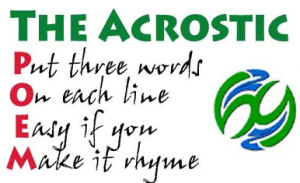After reading Gill James article, Writing Creatively in Another Language, I feel inspired by all the possible activites that can be offered to differing levels of students:
1. Write a Haiku on any topic (five, seven, five syllable combination)
The (beginner) learner,
– confirms what they know about the language
– gives some attention to the sounds of the language
– creates something they own
2. Write an Acrostic Poem about yourself
The (intermediate) learner,
– extends their vocabulary by using a bilingual dictionary
3. Write with your senses see, hear, smell, taste
The (advanced) learner:
– observes and analyses what he/she sees, hears, smells, tastes around him/her
My Freestyle Acrostic Poem
Despite the great examples, I still feel tentative about unleashing a creative task on my young learners. That said, I do recognise the acrostic poem as something I have used before when teaching the topic of ‘friends’ to intermediate students. I like this style because the rules are quick and easy to pick-up: the first letters of each word in the poem spell out the word of the topic in question. For example, if the topic is ‘your best friend’, I would simply ask my students to write down their best friends’ name, vertically on the page. After brainstorming the words of phrases that describe him/her, I’d encourage them to write the acrostic poem, giving them a model for guidance:
Never too busy
Always ready to listen
Open and loving
Modest and kind
Impossible to forget
This writing activity can be extended into a speaking activity, by asking students to ask each other for examples of how their best friends’ demonstrate the adjectives used to describe them.
References
James, G. (2006), Writing Creatively in Another Language




Haikus are great. I once taught a writing class, and we wrote ten of them together over the course. It was excellent; allows us to really dig in to expressing their feelings/thinking (something about which the majority of my students express doubt) using short, digestible sentences or phrases.
I would prefer using these kinds of poems, haikus or acrostics, for integrated or purely oral lessons. You suggest using it as a spring board for longer conversations; sounds much more useful than other methods that are more often used, such as asking questions, or just throwing topics at the class for open discussion.
A side note…
I have not decided if rhyming is important to teach or not. Rhyming in many circumstances makes things easier to remember in English and gives us an intuitive sense of the poeticism of the language, its sounds and rhythms and how it’s been used for centuries. However, Chinese students, with the endless homonyms in their language, simply can’t hear it, nor do they understand it. Such a loss.
Anyway, keep it up. I’m looking forward to more:)
Thanks for the comments, K, and for sharing your experience of using haikus in the classroom. You bring up an important point, that crucial to the success of creative activities in the language classroom, is the socio-cultural background of our students. That is to say, some students are simply more open or more aware of alternative forms of self-expression, than others. No more is that true, than here in China, where an emphasis on teaching-to-test, rote learning and memorisation, squeezes out a lot of the individual’s inherent creativity. However, that is not to say that our students are completely devoid of imagination. Indeed, Clarke (2010:3) says, “(creative abilities)…are all universal human characteristics that every single person is genetically endowed with at birth”. With this we can take heart, that in exposing our learners to creative tasks in the language classroom, which they are capable of completing, we unlock huge potential for linguistic improvmenent, critical thinking and self-reflection.
Good point about music/rhythm in the Chinese classroom. I know I’d like more in terms of being a learner. And perhaps, as a teacher, I need to ensure that any rhythmic-based lesson has the necessary scaffolds, bearing in mind a lack of sensitivity to rhyming words, to ensure students are successful in completing their tasks.
Source: Clarke (2010) Creativity in Modern Foreign Languages Teaching and Learning, Disciplinary Perspectives on Creativity in Higher Education